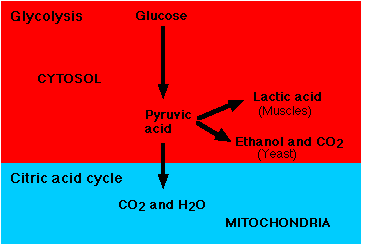Pyruvic Acid
In YEAST
- Pyruvic acid is
decarboxylated and
reduced by
NADH to form a molecule of carbon dioxide and one of ethanol.
- C3H4O3 + NADH +
H+ -> CO2 + C2H5OH + NAD+
- This accounts for the bubbles and alcohol in, for
examples, beer and champagne.
- The process is called alcoholic fermentation.
- The process is energetically wasteful because so
much of the free energy of glucose (some 95%) remains in the alcohol (a
good fuel!).
In active MUSCLES
- Pyruvic acid is reduced by
NADH forming a molecule of lactic acid.
- C3H4O3 + NADH +
H+ -> C3H6O3 + NAD+
- The process is called lactic acid fermentation.
- The process is energetically wasteful because so
much free energy remains in the lactic acid molecule. (It can also be
debilitating because of the drop in pH of overworked muscles.)
In MITOCHONDRIA
- Pyruvic acid is oxidized completely to form
carbon dioxide and water.
- The process is called cellular respiration.
- Approximately 40% of the energy in the original
glucose molecule is trapped in molecules of ATP.
|



